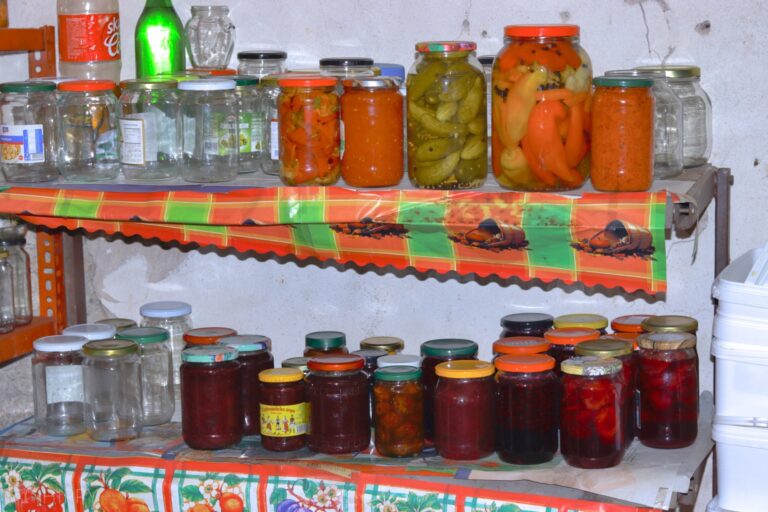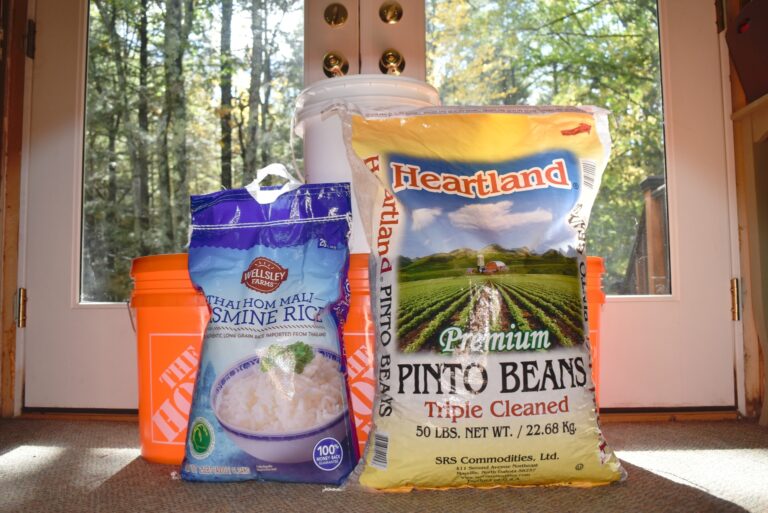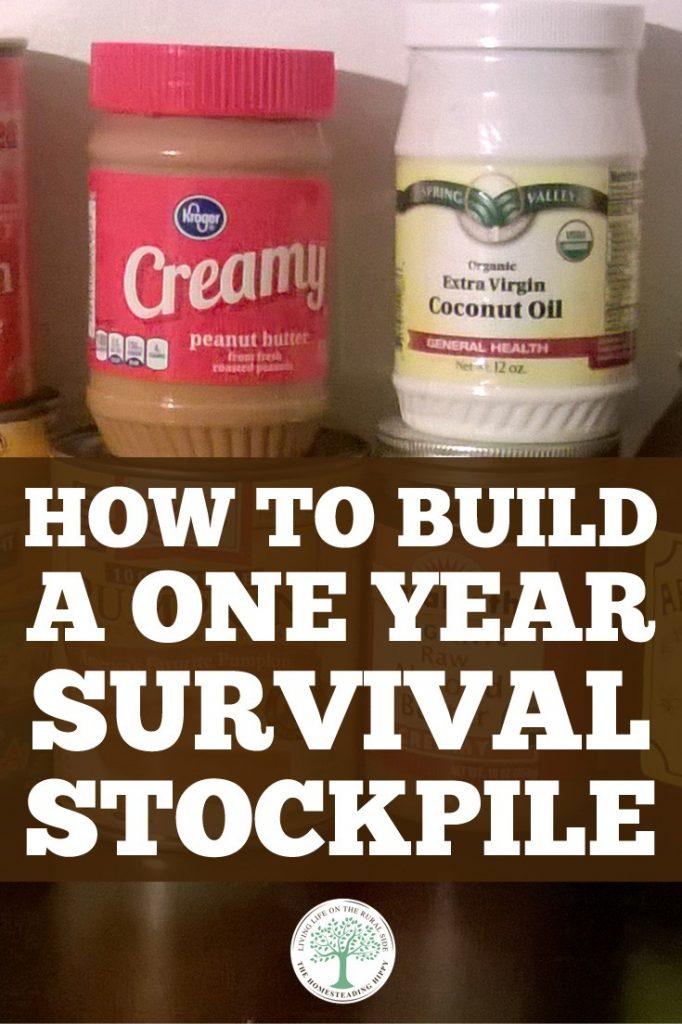Making a stockpile of survival foods to last up to a year. Step by step instructions on stockpiling for 3 days, 3 weeks, 1 month, 2 months, 6 months, and a year.

We make car insurance in the hope that we may never need it, but when we do it will save us from financial ruin. However when it comes to stockpiling food, water and other essentials it’s not just financial ruin but our very lives at stake.
So why isn’t everyone doing it? Because we believe we’ll be lucky enough never to have to face an earthquake, hurricane, tsunami, flooding, blackout, being snowed in for weeks, a flu pandemic or political turmoil.
When it happens and if we are unprepared, then it’s likely to be a very stressful and scary time as we fight to survive.
In World War II, the German army laid siege to Leningrad (formerly St. Petersburg and now back to its original name when the Soviet Union collapsed in September 1991).
By the end of the siege, some 632,000 people had died from a population of around 2.6 million, which included the 100,000 or so refuges who flooded into the city when the German tanks approached.
This article details what people did to survive. No one wants to go through what the people of Leningrad had to endure! Those who had prepared were the ones who survived.
Planning for disasters can prove priceless – and what you stockpile isn’t wasted.
You simply rotate your stores using the first-in-first-out principle, replacing items with new ones, so you always have your stash intact, ready for an emergency.
Check out this lady’s tour of her stockpile for inspiration:
Table of Contents
How Long Should My Stockpile Last?
Emergency services recommend having a stockpile that will last for 3 days, but in emergencies you could be cut off for 3 weeks as we have seen in the case of some hurricanes, major floods, or with the COVD-19 pandemic and ensuing lockdown in China and Europe.
Just think of the lockdowns. How many had a stockpile of food to tide them over when it was highly recommended to NOT get out of the house?
Should SHTF, it could be 3 months, and in case of warfare it could be as bad as it was for the people of Leningrad who had to survive for three years.
We will show you how to stockpile for up to a year in advance making sure you are prepped for most difficult emergencies.
If you are new to stockpiling, start small with the three day stash. Once you think you have it nailed then put it to the test by living off it for three days.
No rushing off to the store for something you forgot, or sneaking stuff from another source that is not in your stockpile!
Keep a journal of what you ate and what you felt could be improved and most importantly what you forgot!
It is probably best to do the test during the weekday when you probably will be busy at work all day and not having visitors over who could wreak havoc with your plans. From there progress to longer periods and see how you do.
How Many Calories Should I Plan For?
This depends on a number of factors. The World Health organization suggests 2000 calories per day for a woman and 2500 per man to maintain weight.
However, keep in mind this is not adjusted for survival situations. When surviving, you’re likely to spend more energy doing things, evacuating, or running for your life.
This little table provided by Healthline helps you calculate calories needed according to weight, height, and age.
Remember, though, that a certain amount of food can be spoiled for various reasons. You may also help a person in need out with some items, so always stash around 10% extra.
Top Shelf-Life Foods
Some foods have it all: lots of micro and macro nutrients, long shelf-life, and they’re things we already eat on a daily basis.
Here is a shortlist of staple foods for your survival stockpile…
When you visit a link in this article that takes you to a different website where you can purchase something, I may earn a commission. Read my full disclosure for more details.
| Food | Shelf Life |
|---|---|
| white rice | 4-5 years |
| dried beans | indefinite |
| tuna cans | 3 – 5 years in your pantry |
| spam | 2-5 years |
| dry pasta | 1 – 2 years |
| honey | indefinite |
| peanut butter | 6 – 9 months unopened |
| salt | indefinite |
| sugar | indefinite |
| juice powders | |
| powdered eggs | 5 – 10 years in a cool place |
| multivitamin and mineral complex | |
| powdered cheese | 12 months from date of packing |
| protein bars | 3 – 5 years |
| freeze-dried food | up to 30 years |
| condiments | |
| pemmican | this is up for debate, but it could last for up to 20 years in the freezer |
| dehydrated fruit | up to 5 years under the right conditions |
| whole grains |
We talk more in depth about food staples here.
Detailed Food Selections
This calorie counter provides information on the protein, fat and carb content plus a whole lot more information on over 37 000 food and beverage items, to give you an indication of what a particular item is worth to your survival stockpile.
Carb-Rich Foods:
| Food | Shelf Life |
|---|---|
| wheat flour | 6-8 months in the fridge, up to a year in the freezer |
| rice flour | up to 8 months in polyethylene bags |
| white rice | |
| quinoa | 2-3 years in either the fridge or pantry |
| popped rice | steel cut and rolled oats |
| semolina | dried potatoes |
| cornmeal | couscous |
| millet | cornflakes |
| pasta | coconut flour |
| almond flour | pea flour |
| corn flour |
Protein-Rich Foods:
| canned meats | canned fish |
| beans | nuts |
| lentils | chickpeas |
| seeds | packaged grated parmesan |
| powdered milk | powdered eggs |
| powdered cheese | boxed tofu |
| condensed milk |
Vitamin rich foods: canned tomatoes, tomato puree, canned pumpkin, peas, carrots, dried vegetable soup mix, dried fruit, multivitamin supplements.
Foods Rich in Healthy Oils:
| Food | Shelf Life |
|---|---|
| olives | |
| live oil | 1-2 years (in the pantry or fridge) |
| flaxseed | |
| flaxseed oil | |
| grapeseed | |
| virgin coconut oil | indefinite |
| butter | 6 – 9 months in the freezer |
Seasonings and Sundries:
| dried instant yeast | cinnamon |
| chili powder | ginger |
| cumin | black pepper |
| white pepper | salt |
| dried garlic flakes | whole cloves |
| star anise | dried coriander |
| mustard powder | bay leaves |
| soy sauce | sugar |
Medium and Long Shelf-Life Snack Foods:
popcorn, rice cakes, crackers, granola bars, fruit and seed bars, nut brittles, jam, chocolate, coconut flakes, peanut butter,
Beverages for Your Stockpile:
| tea | coffee |
| powdered fruit drink | sports drinks |
| soda | vodka |
| whiskey |
Of course, the most important beverage to stockpile is water!
Sample Daily Meal Plan
A daily outline plan for the average adult will give an idea of how much to store for a number of family members, multiplied by the number days.
The quantities for a whole year can be huge! This is why it’s important and cost-effective to eat your stockpile, not just store it for dark times.
This meal plan is for the first few weeks as your fresh potatoes and onions will keep that long. Once we move beyond 3 weeks, there will be more reliance on canned and dried foods.
Breakfast
- 1 serving size packaged cereal or 1 serving cooked oats
- scant handful of dried nuts and fruit
- powdered milk mixed with water for the cereal
- 1 cup coffee, tea or large glass of water.
Mid morning snack
- water and a granola bar
- 1 piece of fruit
Lunch
- 1 portion instant mashed potato
- 1 portion canned chicken/tuna/beef
- 1 portion canned mixed veg or green beans
- large glass of water plus coffee/tea/sports drink or other beverage
Mid Afternoon Snack
- Crackers with processed cheese
- granola bar or rice cakes with peanut butter
- water, tea or coffee
Dinner
- pan fried fresh potato chunks, one medium size potato per person
- ½ fried onion added to one portion of beef stew in a can
- For dessert dried apple slices cut into wedges and dipped in cinnamon sugar/ canned peaches or other fruit of choice.
- 2 large glasses of water; one at supper and one in case of thirst during the night
Your dietary choices determine your stockpile – some people prefer to avoid carbs – but there are carbs in many of your vegetables too.
Some people prefer to cook dried foods rather than relying on canned food – but then you must have planned for adequate cooking supplies- either gas or firewood.
If you are in an apartment you will be limited to the amount of pots you can have with fresh herbs and some vegetables to supplement your stockpile.
If you’re on a homestead, bear in mind some of your crop and your animals may be taken by other people desperate for food. All stockpile quantities are for one person.
Building a 1 Year Stockpile for One Person
Sample 3-Day Stockpile
This will vary depending on whether you are on the move or stuck in one place, on whether you have access to a cooking source like a gas stove, or are surviving with no means to heat food.
Goods inside a freezer will keep cold as long as you refrain from opening and closing it often in the event of a power outage.
The following suggestions are for someone who is at home and has access to a cooking stove, where they can make a fire or use gas for cooking:
- 4 lbs kg fresh potatoes or instant mashed potatoes with 3 servings
- 4 lbs rice
- 3 single serving cans chicken, beef, or fish
- mixed vegetables
- a pack of cereal/oats
- 5 gallons drinking water
- 6 teaspoons instant coffee or /6 teabags (you can make more than one cup of tea with a teabag)
- 2 energy drinks/boxed fruit juice
- 1 box crackers or package of rice cakes
- 1 jar of peanut butter
- 4 single portions processed cheese
- 4 granola bars
- 2 scant handfuls of nuts/seeds/dried fruit mix
- various seasonings: salt, pepper, etc.
Sample 3-Week Stockpile
It is safer to presume you will lose power during an emergency this long. This means you’ll have to rely on alternative ways to heat yourself and, more importantly, to cook!
If storing items like rice and beans that need cooking, make sure you have sufficient gas or firewood to last and extra water for cooking them.
- 1 ½ gallons of drinking water per day, equals 31.5 gallons
- Apples – fresh
- Barley
- Beans – tinned or fresh
- Beef – canned
- Butter/margarine
- Butternut or pumpkin – fresh
- Chicken/turkey – canned
- Chickpeas – canned
- Condensed milk/long life milk
- Oil of choice – olive oil and coconut oil are healthiest
- Couscous
- Crackers
- Custard – small boxed ready-made
- Dried yeast for making quick flatbreads on a griddle if you don’t have an oven
- Granola bars
- Ham – canned
- High fiber cereal
- Honey
- Lemons – fresh
- Lentils
- Meals in a can – e.g. spaghetti and meatballs
- Nut butter – almond, cashew, or peanut butter
- Nuts
- Oats
- Onions – fresh
- Oranges – fresh
- Pasta dried or canned
- Peaches/pears/or other fruit of choice – canned
- Popcorn
- Potatoes – fresh
- Quinoa
- Raisins or other dried fruit
- Rice – small quantities of various types like brown, red, and basmati.
- Salt/pepper/ seasonings of choice
- Soups – canned or packet soups
- Split peas
- Sugar
- Tea/coffee
- Tomatoes – canned
- Tuna
- Wheat flour
1-Month Stockpile
- Essential: 1 ½ gallons of water per person – 45 gallons.
Many of the items will be the same as for the 3 week stockpile as the fresh items should last. You may want to include a few more preserved items such as:
- Apples some fresh and some canned
- Eggs – fresh, some powdered egg
- Fruit juice – boxed – without added sugar
- Jam/jelly of choice – suggest 2 small cans for variety
- Lemons – some fresh and one bottle pure lemon juice
Also store some whiskey, vodka and wine if you enjoy these beverages. Wine can also be used to flavor stews, and you can make beer bread in a pot.
2-Month Stockpile
- Essential: Store 90 gallons of water per person
This stockpile will rely on the fresh items suggested in the 3 week and 1 month lists to use first, then leaning to more of the canned and dried foods as you get into the second month.
Sample 6-Month Stockpile
- Essential: Store 270 gallons of water per person
Here you are going to eat as many of your fresh items as possible during the first month then move over to the canned and preserved foods as well as the pre-packaged freeze dried meals.
Always try products for yourself before investing in a stockpile you may not like to eat!
Include enough bottles of a good multivitamin, as you won’t be having fresh fruit and vegetables from the second month.
Pemmican is a survival food that will last a very long time made from lean dried meat – it can be beef, bison, elk or deer.
The well dried meat is crushed fine and mixed with hot rendered beef tallow, sometimes with the addition of dried and crushed berries.
Growing It Up to a Year
- Essential: Store 547 gallons of water per person
As you’ll see the quantities start becoming enormous for one person, never mind a family.
What you store will depend on space available – if you are in an apartment you’ll need to look at items that take up the least amount of space like the prepackaged freeze dried food.
If you own a larger home you may have one room or a basement to use for storage and can store more of a variety of foods.
The reliance during this longer term will be on the prepackaged freeze dried meals, rice, dried beans and lentils, hard tack biscuits, pemmican and canned food. Remember to buy enough bottles of multivitamins to last the year.
Stockpiling Tips
Use mylar bags and oxygen absorbers to store your food.
To increase the shelf life of some of your stockpiled foods, many preppers put them in airtight containers, along with some oxygen absorbers. lack of oxygen can substantially increase shelf life of many of these foods.
Here’s a neat video on how to do it:
Water is more important than anything.
Water takes preference above everything else – you can survive without food for three weeks – without water 3 days only. One gallon of water minimum per day per person and per pet –don’t forget the animals.
If disaster strikes in summer increase that stockpile to 1 ½ per day and always have at least 5 gallons extra just in case a person needs rescuing and you must provide help, or wounds need cleaning with pure water.
Use unopened commercially available water – it has been purified so it won’t start growing nasty stuff in it. For short term you can use tap water if it’s safe, but don’t store for longer than three months.
Stock up on tools and utensils.
In order to consume your growing stockpile, you will need to things:
- things to cook it with
- things to consume it with
So don’t forget to also get kitchen utensils such as cooking pots, pans, knives, cutting boards, veggie peelers, colanders, graters, shears and many more.
Make sure you have metal and plastic plates, cups, glasses, forks, knives, spoons etc.
Also, keep a manual can opener handy – the electric one is useless in a power outage! Ring pull cans are a good idea.
Buy items in the right sizes to suit your family.
Buy small can sizes –yes bigger sizes are cheaper but if there is no power a half- eaten can is wasted if you can’t keep it cool and who wants to risk food poisoning in an emergency?
For a larger family, buy the can size that your family will finish in one meal without leftovers.
Ration packs for long term.
Don’t buy the emergency ration packs for short term stockpiling – those are for the longer one-year plans when everything else has been exhausted as they have a shelf life of up to 5 years.
Who wants dehydrated food when you can have a delicious stew with fresh potatoes, chunks of beef and all the herbs and spices?
Repacking some of your goods may be a smart idea.
Remove items like cereal and tea packed in cardboard and repack into glass, metal or, at a pinch, strong plastic containers that seal well.
If the item is in a foil fresh pack leave that intact and place in your rigid container to maintain freshness, and to keep it safe from insects, rodents, and weevils.
For this reason don’t store in huge containers – if the food you bought perhaps already had weevils you don’t want to have to throw out a massive container – keep containers limited to the size for a one meal or two using glass containers you have kept and repurposed.
Make sure you label containers with the contents and expiry date.
Stock up on food that is easy to prepare.
Check preparation instructions and recipes online and in cookbooks.
If you need to boil water to regenerate your food, perhaps you shouldn’t include that much of. It may not be possible in a long lasting emergency once the firewood has run out.
If it can be mixed with room temperature water then it’s fine to include.
Be careful about shelf life and expiration dates.
For longer term stockpiling choose tinned or canned goods, and dry goods, as well as nuts and dried fruit. Fresh potatoes and apples can be stored for long periods of time in the right conditions.
Expiration dates are often printed in really tiny print in pretty inaccessible places so use some white stickers and a permanent marker and stick on the expiry date where you can easily see it.
Or write directly on the can or container. Store with the expiry dates facing outwards so you can see at a glance what needs to be used first.
Stock up on a variety of foods, so you don’t end up eating the same things over and over again.
People easily get bored with one type of food so if you are stockpiling say, rice, then buy different types – ordinary white rice, basmati, short grain arborio rice (for making risotto), brown rice, red rice, and wild rice to ensure meals can be varied.
Just keep in mind the different shelf life. For example, white rice will last longer than brown rice.

Stockpiling for people with special needs.
Items will vary depending on allergies, taste preferences, and dietary requirements like gluten free, non-dairy, vegetarian, vegan etc, but should cover the main food groups.
Final Word
So, how big is your stockpile? What items do you have or plan to include? Be sure to pin this for later!


As a child I wanted to grow up and marry a farmer… simply because it was so different from my life right on the shores of the ocean. Well, I didn’t marry a farmer but a surfer instead. The urge, however, to grow stuff and make great food for a big family never left. We are on acreage with a sea view and easy access to fresh caught crayfish and other seafood – the best of both worlds. As an artist and writer I enjoy creating new recipes, tweaking traditional ones, and sharing the results not only with family and friends, but online. Mee the rest of the team at this page.

Water should be recycled about every 3 months even in food safe containers due to leaching. But nice lists. Thank You